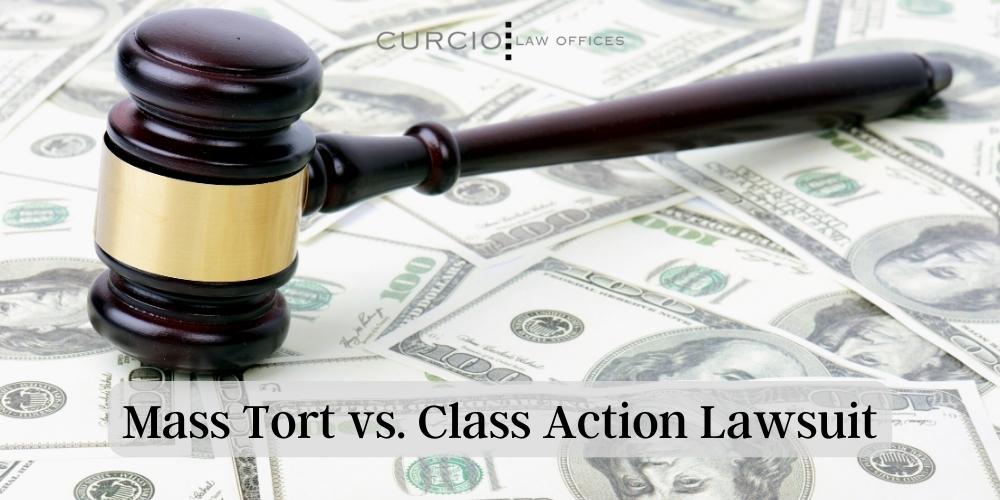Mass tort and class action lawsuits are very similar in that they are civil procedures filed by a large group of people for relatively the same grievance. Usually, this grievance is a major injury, illness, or death caused by a wrongful act. However, the two types of cases differ in that plaintiffs have far more control over the outcome of mass torts. Meanwhile, plaintiffs in class actions don’t really serve a purpose or have a specific role. They can even choose to opt out of the lawsuit entirely if they want. Below, the legal team at Curcio & Casciato breaks down a mass tort vs class action lawsuit, including the procedural differences, common types of cases, and so much more.
If you or a loved one suffered a major injury, illness, or death from defective drugs, defective products, defective medical devices, and toxic substances, you may have grounds to recover financial compensation in a civil lawsuit. Chicago personal injury lawyers at Curcio & Casciato have been protecting and defending the rights of community members for more than 65 years. We are the strongest legal team to have on your side after you’ve suffered an injustice. Call 312-321-1111 to schedule a free consultation today.
What is a Mass Tort?
Let’s start with the basics: a tort is a civil wrongdoing that results in a personal injury or wrongful death. The injured party (or the surviving family members of the wrongfully killed party) can then recover financial compensation through a civil procedure.
A mass tort is basically the same thing, except instead of one person injured or killed by a civil wrongdoing, lots of people are injured or killed by a civil wrongdoing. Mass tort lawsuits generally involve multiple plaintiffs against the same defendant(s). The defendant in a mass tort claim is usually a large company or a few specific people at a company.
In mass tort cases, the defendant(s) must have caused a large number of similar injuries through the same wrongful act.
Common Types of Mass Tort Claims in Chicago
Common types of mass tort claims include:
Defective Medical Devices and Drug Injury Lawsuits
Defective medical device injuries and mass drug injuries often warrant mass tort claims.
Our Chicago drug injury lawyers have extensive experience with defective joint replacement injuries and Paragard injury claims in Chicago and defective joint replacement injuries. We also help with Xarelto, Xeljanz, and Zantac injury lawsuits in Chicago.
Product Liability Claims
Major product liability claims for defective products also fall under mass tort claims. Our Chicago defective product attorney team also assists with Takata airbag explosions, Ford death wobble claims, hair relaxer lawsuits, etc.
Mass Transit Accidents
Mass transit accidents are one of the more unique mass tort claims in Illinois. As one of Chicago’s oldest law firms, Curcio & Casciato is home to some of the most experienced mass transit accident attorneys, including:
Major Disasters
Major construction accidents, explosions, and mesothelioma claims are often mass torts in Illinois.
Our Chicago construction accident attorneys also have experience in major construction disaster claims in Illinois. And if you’ve been injured by asbestos exposure, our Chicago mesothelioma lawyers can help.
Additionally, workers or tenants who have been injured by fires and explosions should contact the experienced Chicago explosion accident lawyer team at Curcio & Casciato.
How Does a Mass Tort Work?
Mass torts often begin as a handful of individual lawsuits filed in state or federal court. To save time and resources, many judges will combine these individual lawsuits into a single mass tort action. Judges can even decide to combine multiple lawsuits from many different jurisdictions. This is called multi-district litigation.
Despite being part of a multidistrict litigation, each individual plaintiff still has the right to have their own legal counsel, but they must work at the same pace as all the other mass tort plaintiffs.
Mass torts generally end with all of the individual plaintiffs receiving a fair settlement in order to cover all the damages suffered.
What is a Class Action Lawsuit?
Mass tort and class action lawsuits are similar in that multiple plaintiffs have suffered major injuries and/or death due to wrongful acts committed by the same defendants. The main difference is how much control prospective plaintiffs have over the outcome of the case. In a class action lawsuit, each individual plaintiff doesn’t have a huge role. Instead, a class representative will step forward to represent all of the injured plaintiffs as a whole.
Common Types of Class Action Lawsuits
Common types of class action suits are:
- Defective product injuries
- Defective medical device injuries
- Injuries caused by defective drugs
- Environmental issues such as maintaining a clean water supply and preventing pollution
- Civil rights issues (e.g. Brown v. Board of Education in 1954)
- Financial issues such as consumer fraud
- Employment issues between employers and employees
Requirements for a Class Action Lawsuit
Class actions typically occur in federal courts. Before a class action suit can proceed, it must meet the federal rules specifically designed for certifying class action lawsuits. These rules are as follows:
- The class size is large enough to the point where filing individual lawsuits would be unfeasible.
- The entire class shares the main issue addressed in the lawsuit.
- The full class shares the same claims and defenses as the class representatives.
- Class representatives have the ability to adequately protect the interests of other class members.
Basically, a mass tort case is a legal case that does not meet the federal rules of civil procedure for a class action.
How Does a Class Action Lawsuit Work?
Unlike mass tort actions, class actions don’t need every single plaintiff to agree to move forward before the lawsuit actually moves forward. In other words, plaintiffs have the option to opt out of the lawsuit at any point. The plaintiff can then choose to file their own individual lawsuit with their own legal counsel or just drop the issue entirely.
If a plaintiff chooses to opt out of the class action, they likely won’t receive a settlement of any kind. The individual settlements for some class actions are fairly small anyway – depending on how many plaintiffs are injured and how much the overall settlement is – so some plaintiffs decide that they can receive a larger settlement if they choose to opt out and proceed with their own tort lawsuit.
How To Know if You Have a Mass Tort Case or a Class Action
After enduring such a traumatic injury or death, it can be difficult to know the difference between a mass tort vs class action lawsuit. Additionally, it can be difficult to know exactly what kind of case you have. For decades, Chicago personal injury lawyers at Curcio & Casciato have been helping injured clients obtain justice and compensation through both mass tort lawsuits and class action lawsuits. We can analyze the details of your situation and help you determine which type of lawsuit would be best for you. Then, we’ll defend your legal rights throughout the entire class action or mass tort litigation process.

Call a Chicago Personal Injury Lawyer at Curcio & Casciato Today
If you or a loved one was injured or killed due to defective drugs, defective products, defective medical devices, or toxic contamination, you may have grounds to pursue legal action. The legal team at Curcio & Casciato has been protecting and defending the people in the Chicagoland area since 1957. We have the skill and experience necessary to take on your case and make sure you receive a fair settlement. Call 312-321-1111 to schedule a free consultation at our law firm today.



